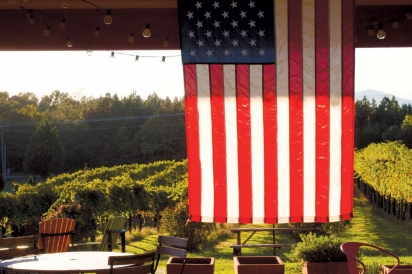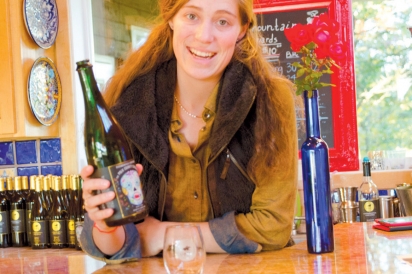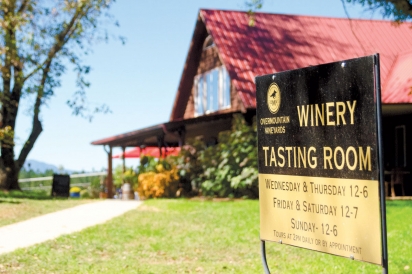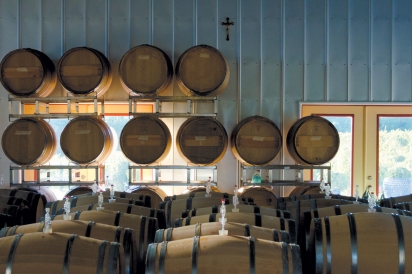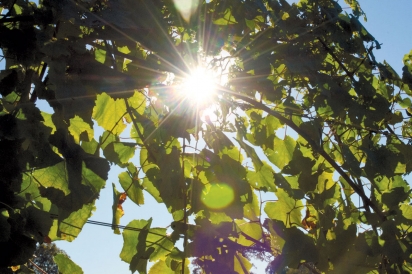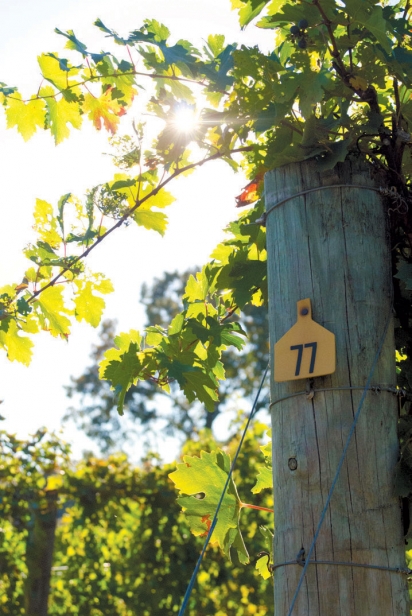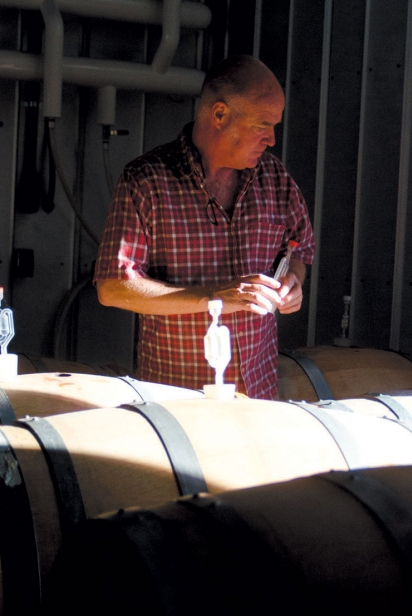Family Roots
The Wine Country of Western North Carolina
Before tobacco fields stretched as far as the eye could see; before wanderers flocked to the mountains to view the changing of the colors; before Western North Carolina became a tourist destination—it, specifically the Tryon area, was grape country, known and prized by consumers and winemakers alike.
That’s right: grape country.
In the 1880s, Union General Ulysses Doubleday, who settled in Tryon as the climate offered relief for his asthma, grew the area’s first known vines. Over time, several other farmers joined him. Perhaps most notable was Alexis LeMort, a Florida fruit farmer who ventured north, purchased 50 acres, and founded Tryon Vineyard.
Some of these farmers, like LeMort, created wines; many sold edible table grapes; others sold their harvests to winemakers elsewhere. No matter the product, the area became known for exceptional grape growing, due largely to its unique terroir in the isothermal belt of North Carolina.
Grapes enjoyed a brief yet significant heyday until the 1930s, when several factors contributed to the industry’s decline. For many decades after, the same land gave way for tobacco farming, which, too, eventually saw its own decline.
The old adage, “history repeats itself,” however, is ever-present today, and the grape is enjoying a renaissance throughout Western North Carolina. Local farmers have taken root to grow the vines and craft the wines. Wineries now dot the landscape from Hendersonville’s apple country to Tryon’s mountains and valleys, each with a unique take on farming and winemaking.
A standout along the Western North Carolina Wine Trail, Overmountain Vineyards (OMV) sits atop 17 acres of French vinifera. This family-owned and operated vineyard derives its name from the land’s history. During the Revolutionary War, local citizen soldiers—the Overmountain Men—banded together to fight the British during the pivotal 1780 Battle of King’s Mountain. George Washington called the battle, “a proof of the spirit and resources of the country.”
The spirit and resources of the country are alive and well at OMV, whose logo—a Patriot rider on horse, perhaps chasing the Brits (or a crisp Chenin Blanc!)—nods to the area’s rich history.
The vineyard began when husband and wife, Frank and Lita Lilly, bought the 70-acre tract of land in 1990. Frank had grown up farming, and after a career in sales and the military, wanted to return to his roots. The Lilly family planted Cabernet Sauvignon in 2000 and over the next four years, added four other grape varieties, including Cabernet Franc, Merlot, Petit Verdot and Petit Manseng, a very rare grape, that “grows so good here,” says Sofia, assistant winemaker and daughter of founders Frank and Lita.
What began as a hobby quickly transformed into a life-changing venture. In 2007, Frank enrolled and studied in the Viticulture and Enology program at Surry Community College and apprenticed under Lee Griffin, the owner and winemaker of Rockhouse Vineyards. This combined education and experience working for one of the region’s most respected winemakers gave Frank the confidence to venture out on his own. In 2010, Frank and Lita opened OMV to the public for wine tastings.
Sofia, who now apprentices under her father and often runs the tasting room, grew up on the farm, learning lessons about the land and the craft of winemaking by watching her father. “Time in the vineyard was family time,” she says.
The family also loves to taste wines together. “My family exposed us to a wild variety of wines,” says Sofia. “My sister has developed the best palate in the family.”
Sofia ventured to college at Western Carolina, where she studied English and biology, which in hindsight seems a perfect combination for someone who wants to farm, craft wine, and interact and communicate with people from all walks of life who come to sample the vineyards’ wares. “English and biology, while seemingly a strange combination, gave me the preparation for everything I do here at OMV today,” she says.
Inspired by her parents’ success and her ever-growing passion for wine making, Sofia recently developed her own hard cider using nature’s most obvious bounty in these parts: Gala and Granny Smith apples. (You can taste the Big Jax Cider at OMV’s tasting room).
It Takes a Farmer
Wine drinkers enjoy the end product so much, it’s easy to forget the labor it takes to make the wine. Winemaking, after all, is farming: knowing the land, painstakingly keeping track of the weather, understanding what thrives in the soil versus what is not suited for growth. In the wine world, terroir—the environmental conditions in which the grape is grown—is king. As Sofia points out, “What we do is farming. We happen to have a product that’s an alcoholic beverage. But, we consider ourselves farmers first.”
OMV is located in the terroir of the isothermal belt, which is an important factor in considering the types of grapes that can be grown. Upon harvest, the Lillys determine what’s best to be made from that particular grape; this is where the craft of the winemaking becomes apparent.
Each year’s harvest tastes very different. Soil conditions and weather directly affect fruit quality, which in turn, affects the taste of the wine. “In North Carolina, vintage means an awful lot. Each year we get what God gives us,” Sofia says.
“We had a terrific harvest last year, which allowed us to really focus on crafting our wines, our way,” says Sofia. Their way means an unfiltered, French technique, “a non-interventionist approach. We don’t manipulate the wines at all.”
“For instance, do you add honey to the Chenin Blanc?” Sophie asks. “No. You depend upon your terroir, the bees, the yeast strain that combines with the juices. A lot of the ultimate taste depends upon the growing conditions themselves.”
Magic in the Glass
Frank took time to develop the land and the business. The Lillys grew grapes for others for 15 years; in fact, during the first three years of operation, 95 percent of the fruit was sold to Biltmore Estates, while the family worked their own tasting room on the weekends.
Time seems to be on their side. Two years ago, Frank retired from his career to focus on farming and winemaking. And last year marked the first year the family kept their grapes for their own wine production; the harvest yielded over 2,000 cases of wine. And they’re not looking back.
“Dad’s always reading the latest literature about viticulture, and we’re continually innovating our processes here at the farm while staying true to the real craft of winemaking, which is about 50 percent art and 50 percent science,” says Sofia.
In 2015, OMV invested in a grape sorting elevator and sorting table, two hightech pieces of equipment that insure only the most pristine grapes (and nothing else) makes it in the finished product. While expensive investments, these technologies have allowed the operation to focus on quality.
“Any time you can slow down production, you increase the quality of the wine exponentially,” she adds. “We’re basically using new-world technologies to produce old-world wines.”
Together, the art and science combine to create a balanced product that reflects the land and the family. “I like to say you can taste magic in the glass,” says Sofia.
The Details
OMV is famous for its Rosé, a Provencestyle, dry wine with good acidity. The Patriot Red is medium-bodied, French oak-barreled for 20 months. The Muscadine Wine is on the drier side, without the typical syrupy sweet aftertaste. The Viognier offers a crisp, clean finish with notes of green apple and pear. A crowd favorite, the Muscadine Port is fortified with French brandy, which gives it a surprising flavor and lots of complexity. Of course, there are many other wines available, and selections change with each harvest.
OMV hosts more than 120 tastings a month and rounds out their offerings with seasonal concerts, weddings, and corporate events. During the cooler months, a communal firepit just outside the tasting room offers a perfect place to relax and catch up with friends. A swing hanging from a high branch of a nearby tree beckons the kid inside all of us. OMV has its regulars, or what Sofia calls “permanent fixtures” in the tasting room. But with the popularity of the wine trail increasing visitors to North Carolina, she welcomes the chance to visit and get to know new faces as well.
“We’re part of this community: the equestrian community, the historic Tryon community, the visitors who come to our mountains for an experience,” Sofia says. “We consider everyone family.”
Overmountain Vineyards
2014 Sandy Plains Road
Tryon, NC
Tasting Room Hours
Wednesday, Thursday, Sunday: Noon-6pm
Friday and Saturday: Noon-7pm
(828) 863-0523
www.overmountainvineyards.com
TASTE OF OUR CAROLINA FOOTHILLS
September 18, 1pm-5pm
FENCE
3381 Hunting Country Road
Tryon
If you're thinking to head up to visit these vineyards, there's no better time than during the third annual Taste of Our Carolina Foothills, an afternoon filled with food and drink vendors on the grounds of the Foothills Equestrian Nature Center, right in the heart of wine country. More information and tickets available at www.eventbrite.com/e/taste-of-ourcarolina-foothills-tickets-26691540115



